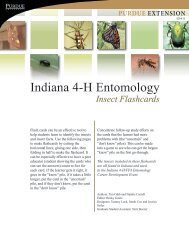Pink Gypsy Moth - aphis - US Department of Agriculture
Pink Gypsy Moth - aphis - US Department of Agriculture
Pink Gypsy Moth - aphis - US Department of Agriculture
Create successful ePaper yourself
Turn your PDF publications into a flip-book with our unique Google optimized e-Paper software.
infested material. Movement <strong>of</strong> potentially infested material is more fully<br />
characterized in the next section.<br />
Remarkably, a substantial number <strong>of</strong> unspecified lymantriid interceptions (<strong>US</strong>DA<br />
2005) were associated with cut flowers, for example Oncidium sp. (24%),<br />
Orchidaceae (7%), Dendrobium sp. (5%), and Astilbe sp. (2%). These plants are<br />
not known hosts for L. mathura, and it is possible that insects were strictly<br />
hitchhikers. However, only ~16% <strong>of</strong> the infested items came from a country<br />
known to have L. mathura. Thus, it seems unlikely that all or even most <strong>of</strong> the<br />
interceptions would have been <strong>of</strong> L. mathura.<br />
Even if all unidentified specimens <strong>of</strong> Lymantriidae had been L. mathura, this<br />
insect would still have an apparent low potential for entry, relative to other exotic<br />
insects. Although we assign a low rating to the potential for entry, we recognize<br />
that not all pathways for the introduction <strong>of</strong> forest pests have been studied with<br />
any detail. Consequently, a great deal <strong>of</strong> uncertainty is associated with the rating.<br />
6. Destination <strong>of</strong> Infested Material. Rating: Medium. When an actionable pest is<br />
intercepted, <strong>of</strong>ficers ask for the intended final destination <strong>of</strong> the conveyance. The<br />
shipments intercepted with L. dispar and “Lymantria sp.” were destined for North<br />
Carolina and Oregon, respectively (<strong>US</strong>DA 2005) Materials infested with<br />
“Lymantriidae” were destined for 17 <strong>of</strong> the contiguous United States. The most<br />
commonly reported destinations were California (38%), New York (24%), Texas<br />
(6%), Florida (6%), Georgia (3%), Illinois (3%), and Massachusetts (3%) (<strong>US</strong>DA<br />
2005). Some portion <strong>of</strong> each state identified as the intended final destination has<br />
a climate and hosts that would be suitable for establishment by L. mathura, yet<br />
probably very few <strong>of</strong> these interceptions involved L. mathura. Consequently,<br />
available data do not permit a confident evaluation <strong>of</strong> this element.<br />
7. Potential Economic Impact. Rating: High. Lymantria mathura larvae are<br />
gregarious defoliators, able to consume whole leaves and sometimes avoid tough<br />
veins in older foliage growth. Larvae may also feed on flowers and tender young<br />
shoots (Browne 1968, Roonwal 1979b). Damage <strong>of</strong> this nature can result in<br />
decline in overall growth and development, a reduction in yield or total crop loss<br />
(fruit crops), or even tree death (Singh 1954, Roonwal 1979b).<br />
In India, L. mathura is an economically important forest pest, which defoliates<br />
Shorea robusta, and several other deciduous forest and fruit tree species [see<br />
‘Host Specificity’]. Roonwal (1953, 1962, 1979b) states that outbreaks are<br />
periodic, and prior to the worst epidemic <strong>of</strong> this pest on record in India during<br />
1953, L. mathura was considered unimportant. In India, this severe outbreak<br />
occurred in Uttar Pradesh in the New Forest area <strong>of</strong> Dehra Dun (approximately<br />
610 m in altitude, in the western sub-Himalayas). The outbreak extended from<br />
the western sub-Himalayas to West Bengal, encompassing several adjacent forest<br />
divisions. In the Russian Far East, there has been only one reported outbreak in<br />
the Primorie region, where losses amounted to hundreds <strong>of</strong> hectares <strong>of</strong> deciduous<br />
CAPS PRA: Lymantria mathura 9
















